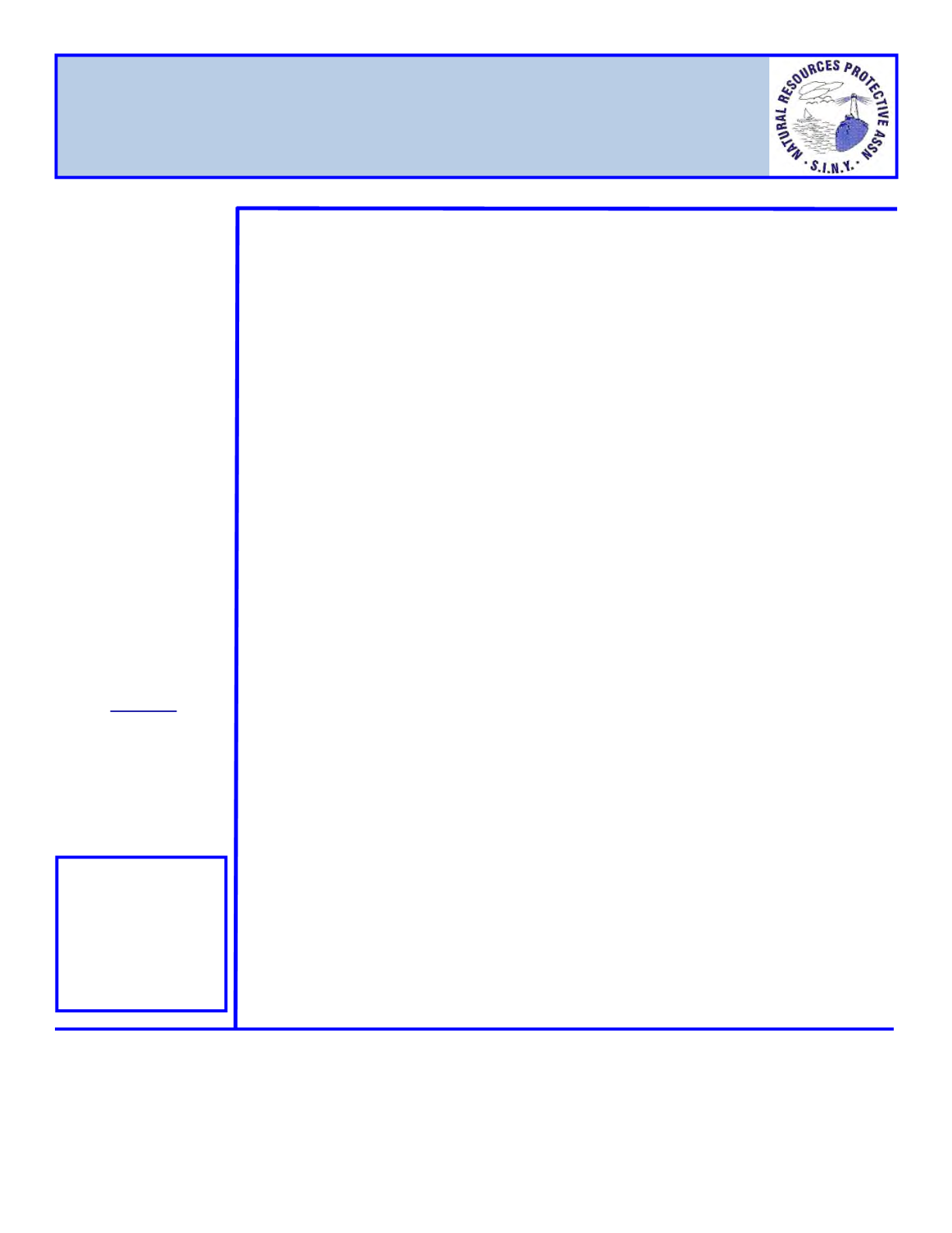
N
atural
R
esources
P
rotec ve
A
ssocia on
Coali on Against Water Disposal of Contaminated Sediments
Post Office Box 050328
Staten Island, NY 10305
A Publica on of the
WINTER 2017
In this Edi on
Executive Director
Ida Sanoff
CAWD
Director
Assistant Secretary
Tony Rose
Staten Island Sport Divers
Director
Treasurer
Membership
Newsletter
Richard Chan
NRPA
President
Jim Scarcella
NRPA
Friends of Clearwater
Vice President
Charles Perry
Protectors of Pine Oak
Woods
Secretary
Daniel Ingellis
NRPA
Assistant Treasurer
John Malizia
S. I. Yacht Club,
S. I. Tuna Club, FCA
TRUSTEES
Dr. Martin Schreibman
Brooklyn College AREAC
Dr. John T. Tancredi
Molloy College
Cindy Zipf
Clean Ocean Action
Page 1 The Borrow Pit Monster - The Thing That Refuses To
Die!
Page 2 Gotham Whale
Page 2 Amazon Smile
Page 2 Lemon Creek Park Cleanup
Page 3 Oakwood Beach Cleanup
In Memory of Edward “Kerry” Sullivan
Page 3 Conference House Park/Page Avenue Cleanup
Page 4 Seaside Nature Park Cleanup
Page 4 Jamaica Bay – A Controversial Flood Control Project
Page 5 Upcoming Events
THE BORROW PIT MONSTER – THE
THING THAT REFUSES TO DIE!
By Ida Sanoff
It is hard to believe that more than forty years
have passed and we still have to keep
fighting the same battle over and over again:
Opposing the filling of borrow pits. The Bor-
row Pit Monster recently came to life again in
Jamaica Bay.
For the uninitiated, “borrow pits” are deep
underwater depressions in our bays and near
our beaches. Sand and gravel are needed
for building and road construction and there
are companies that get contracts from New
York State to mine it from underwater areas
and sell it. Sand is also needed to replenish
beaches. Massive pipes are positioned from
a beach to a borrow area. Cutterhead dredg-
es dig up the sand and pump the resulting
sand/water slurry through the pipes and onto
the beach. Although the name suggests that
this material is only being “borrowed”, in reali-
ty, it is never returned. So we are left with
these deep underwater pits.
Every so often, a plan is put forth to fill the
borrow pits. But instead of returning the
clean sand or gravel that was “borrowed”, the
plans propose using the most noxious materi-
al around: Type F toxic dredge spoils. Ship-
ping channels and berthing areas tend to be-
come shallower over time and need to be dug
out to a usable depth. The material that is
removed is called dredge spoils and it is al-
most always heavily contaminated with or-
ganic chemicals and heavy metals. Back in
the day, no one really cared about the marine
environment and much of this stuff was
dumped off the coastline in New Jersey. But
the stuff was so toxic that it killed marine life
for miles around and they had to stop doing it.
In the 1970’s someone at the Army Corps of
Engineers came up with a new plan: Let’s
dump this toxic crud into the offshore borrow
pits! But they couldn’t really say that they
were dumping toxic waste, so they came up
with what they thought was a way to make it
acceptable. They said the borrow pits were
dead zones, devoid of marine life and that by
filling them with toxic crud, they would “restore
the bays and ocean bottoms to their historical
depths”. Then they’d throw a few feet of clean
sand on top and voila! Problem solved and no
one would be the wiser.
But someone was wiser and that person was
the late Lou Figurelli, NRPA’s founder. Lou
didn’t have much in the way of a formal edu-
cation, but he sure knew a lot about fish! Lou
and his fishing buddies knew that these deep
areas were just loaded with fish. They kept
carefully detailed records about what they
caught in and around the so called dead
zones of the borrow pits. Along the way,
NRPA was formed, our good friends at Clean
Ocean Action joined Lou in a lawsuit and
some of the borrow pits were spared.
In the 1990’s, because of Clean Ocean Ac-
tion’s efforts, ocean dumping of toxic materi-
als was outlawed in federal waters. But closer
to shore, where state law applied, it was still
theoretically possible to dump the bad stuff
and use it to fill borrow pits.
Every so often, The Borrow Pit Monster, the
Thing that Refuses to Die, is resurrected in
some form or another. And each time, a
broad coalition of shoreline organizations, civ-
ic groups and ordinary citizens join together to
beat it back once again.
At a recent meeting of the Jamaica Bay Task
Force, we learned that someone at the Sci-
ence and Resiliency Institute of Jamaica Bay
was trying to resurrect The Borrow Pit Mon-
ster in Grassy Bay. It is right next to JFK Air-
port and it has a large and deep borrow pit. In
fact, one of the airport’s runways extends par-
tially into Grassy Bay.
Why, all of a sudden, would the Science and
Please join
or renew
your NRPA
membership
TODAY
See page 7


